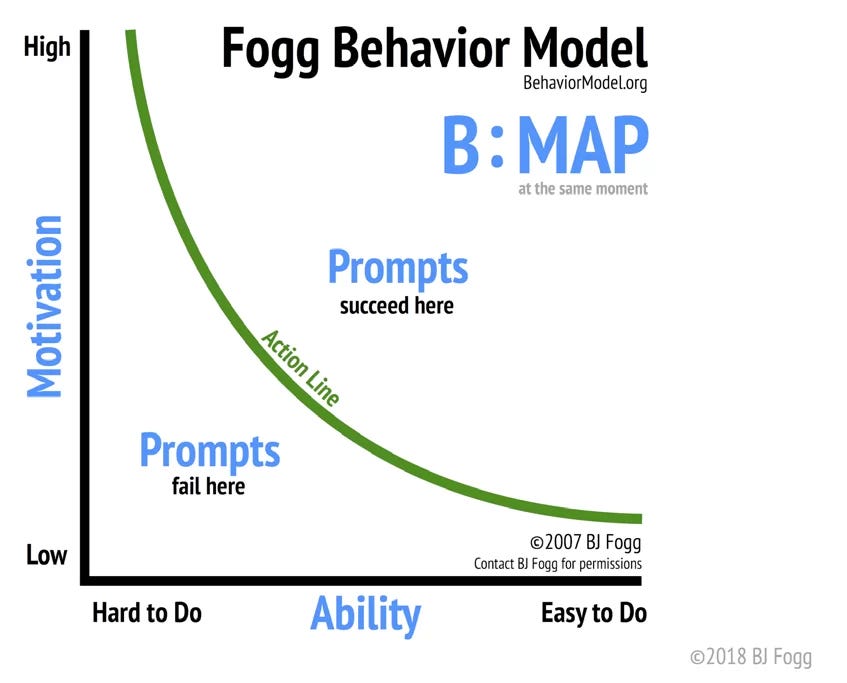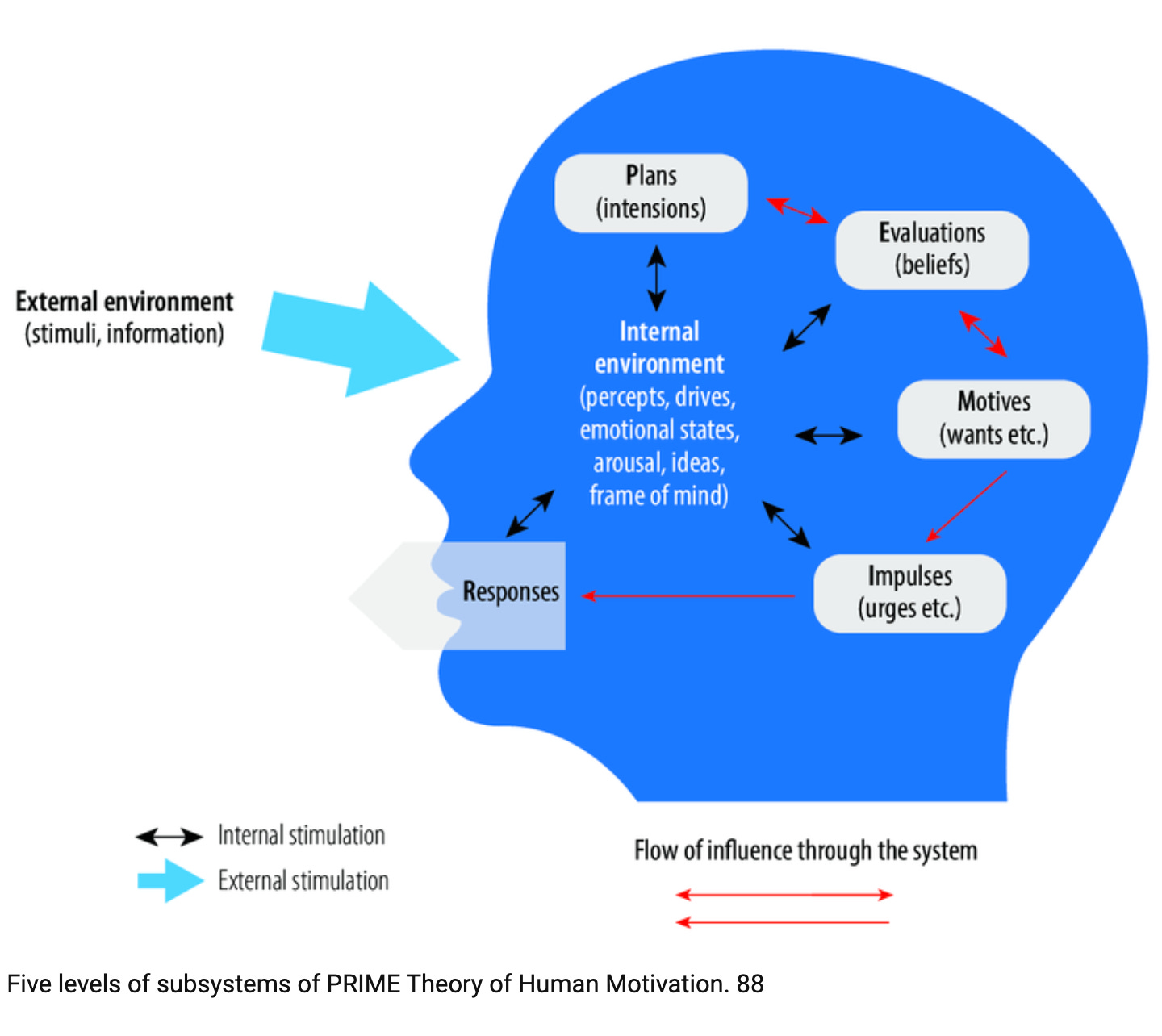The Motivation Masterclass: From Science to Soul
A Comprehensive Guide to Building Motivation That Lasts by Aligning Purpose, Identity, and Action
It’s January 2nd, and it’s go time. As you look at yourself in the mirror, you imagine a whole you new and get pumped.
As you stand there, you tell yourself, 'This is the year I'll get fit and lose weight.'
You then bought new running shoes, downloaded a fitness app, and joined the gym down the street.
Fast forward…
Now it's March 1st.
Those running shoes? Collecting dust by the door.
The fitness app? You've ignored its notifications for weeks.
The gym membership? You haven't been there in a couple of weeks.
It was supposed to be a whole new year and a whole new you.
So, what happened?
You're not alone. About 80% of New Year's resolutions fail within 30 days, with fitness goals topping the list of abandoned commitments.
But why do we consistently struggle with Motivation, especially when we genuinely want to change?
1. The Motivation Mirage
Most of us believe Motivation should be a constant companion on our journey to change. But Motivation is more like weather than climate – it changes daily, sometimes hourly.
When you made that resolution, you were riding a wave of Motivation fueled by the fresh start of a new year.
But waiting to "feel motivated" before exercising is like waiting for perfect weather before going outside—you'll spend most of your time waiting.
2. The Capability Gap
"I know I should exercise, but I'm just not good at it."
When starting a new habit, by definition, we are bound to be ‘foolish.’ And fools fail often before they get it right.
The problem here is this capability gap creates resistance. Your brain is remarkably efficient at steering you away from activities where you expect to fail. Each time you think about exercise and remember past failures, your brain is reinforcing the path of avoidance.
The willingness to be a fool is a precursor to transformation.
3. The Environment Trap
Your alarm rings at 6 AM, but your warm bed feels more compelling than your abstract fitness goal.
The path to the couch is frictionless; the path to fitness is uphill. Your Environment is full of cues triggering old habits while offering little support for new ones.
4. The Values Conflict
"I want to be healthy, but I also want to enjoy life." Getting fit can conflict with other values like family time, work, fun, or spontaneity.
5. The Identity Conflict
Perhaps the most powerful obstacle is the gap between who you are trying to become and who you currently believe you are.
When you say, "I want to get in shape," you're really saying, "I am not someone who is in shape." But if your Identity is built around being "not athletic" or "not in shape," you're fighting against your own sense of self.
This creates cognitive dissonance—a mental discomfort that arises from holding contradictory beliefs. Unfortunately, it's often easier to abandon the new behavior than to revise one's Identity.
6. The Planning Fallacy
"This time will be different. I'll exercise every day for an hour!"
When setting goals, we routinely underestimate the obstacles we will face and overestimate our ability to overcome them. We plan for our ideal selves—the versions of ourselves with endless willpower, perfect circumstances, and no competing priorities.
This planning fallacy sets us up for failure. When reality fails to match our optimistic projections, we often abandon our targets entirely.
The Obstacle is the Way
Understanding these obstacles isn't about making excuses – it's about recognizing the real challenges between intention and action. Most motivation advice focuses on pushing harder, using willpower as a battering ram or just focusing on capability.
But what if there's a better way?
In the following sections, we'll explore frameworks that work with human nature, not against it: the COM-B model to understand behavior drivers and the Dilts model to help us better understand where and how to focus our efforts for maximum impact.
Lastly, we will look at the Prime Theory of Motivation, which puts it all together.
Sections:
COM-B Model: The Foundation of Motivation
Diltz Model: Where to Focus Your Energy
How to Apply These Models: Your Motivation Roadmap
PRIME Theory of Motivation of Behavior
Persuasion: Motivation from the Outside
Your Master Plan with Tools & Assessments
The Heart of Motivation
Part 1: The COM-B Model - The Foundation of Motivation
The COM-B model, created by behavior scientists, provides a clear framework for understanding all human behavior. It breaks down the essential components needed for any behavior to occur.
At its core, COM-B states that three elements must be present for any behavior to happen:
C - Capability: The physical and psychological ability to perform the behavior
O - Opportunity: The physical and social Environment that enables the behavior
M - Motivation: The internal processes that energize and direct behavior
Let's break these down to understand how they work together:
1. Capability: Can You Do It?
Capability is the thee power or ability to do something, and it comes in two forms:
Physical Capability: The bodily strength, stamina, and skills needed
Psychological Capability: The knowledge, mental skills, and cognitive capacity required
A person who is well-spoken and has the ability to share complicated ideas with friends and colleagues but freezes up when they are on stage. Their body is perfectly capable of standing and talking, but their mind lacks the psychological tools to manage their anxiety.
2. Opportunity: Can It Happen in Your World?
Opportunity is a set of circumstances that makes it possible to do something. This has two dimensions:
Physical Opportunity: The Environment, resources, time, and physical accessibility
Social Opportunity: The cultural norms, social cues, and relationships that influence behavior
If you work 12-hour shifts and don't have access to a gym, you can exercise but lack physical Opportunity.
3. Motivation: Do You Want To Do It?
Motivation is the desire to act in service of a goal.
It is divided into areas:
Reflective Motivation: Conscious planning, evaluations, and intentions
Automatic Motivation: Emotions, impulses, desires, and habits
This is where many motivation models fall short - they focus only on reflective motivation (conscious goals and plans) while ignoring automatic Motivation (feelings and impulses that often override our plans).
Why This Model Matters
The power of COM-B lies in its completeness. When behavior change fails, at least one of these components is missing or insufficient.
Most approaches to Motivation focus exclusively on the "M" - trying to pump up Motivation while ignoring capability and opportunity gaps. This explains why so many well-intentioned efforts fail.
The Model shows us that:
No amount of Motivation compensates for lack of Capability or Opportunity
Enhancing Capability and Opportunity actually increases Motivation
Sustainable change requires addressing all three components
In the next section, we'll explore the Dilts model, which helps us understand where to focus our attention within this framework for maximum impact.
Part 2: Dilts Model - Where to Focus Your Energy
While the COM-B model shows us what components need to be present for behavior change, the Dilts model (developed by Robert Dilts) reveals where to focus our efforts for maximum impact.
Think of it as a hierarchy of change, with each level influencing all the levels below it:
The Logical Levels of Change is a powerful model that describes how we operate in the World and how to effect change.
The Model focuses on the following Levels:
Vision: This relates to your Why and your reason for being. It's the bigger picture of your life.
Identity: This refers to the roles you play, your story, and your concept.
Values & Beliefs: This answers the question of what is important to you and 'Why' you behave the way you do.
Capability: This includes your talents, abilities, skills, knowledge, and education. This speaks to your potential for action.
Behavior: This relates to your actions in the World. What you do and everything you do happens in an environment.
Environment: The time, place, and overall context. This can include where you live, your relationships, your career, your financial well-being, your health, etc.
Each of these levels can be highly empowering or limiting.
Why we Fail
When change is hard, often it's because we are working on the wrong level. The most common temptation is to try to fix a problem at the level that it exists.
For example, if we don't like a behavior, like smoking, we try to effect change on the behavioral level. We try to change the behavior via force or suppression, only for all our efforts to fail.
So, how do we work on the right level of change?
We first must discover what levels the problem exists on.
With the Smoker, we need to listen to their language and see what level(s) changes are required.
For example, consider the differences between saying:
"I can't quit" (skill) versus
"Smoking won't hurt me" (belief), versus
"It's a part of who I am" (Identity).
How to Work with the Levels
There is a two-way relationship between these levels and how they affect each other.
The lower levels can inform the upper levels; however, the upper levels produce changes in the lower levels.
Here is how it works:
Information: Lower to Higher
Environment → Behavior: Environment informs our behavior, what opportunities are present
Behavior → Capability: Behavior can inform Capability. By practicing new skills, we can increase our capabilities.
Capability → Beliefs: By becoming more aware of our capabilities, we can update our beliefs about what we can do.
Values & Beliefs → Identity: Updating our beliefs about ourselves has the meta effect of changing how we see ourselves. For example, as we grow, we become a person who can change and evolve (meta-narrative) rather than someone who is fixed, which changes how we see ourselves.
Identity → Vision: As our identity changes, so does our worldview, our perception of our World, our place in it, and our responsibility to it. This can inform our higher purpose and vision of life.
Change: Higher to Lower
Behavior > Environment: You can’t change the Environment on the level of Environment; you need to ACT and behave. You change your Environment via behavior.
Capability > Behavior: Capability determines what you can do. You can not act outside of your Capability.
Values & Beliefs > Capability: Learning a new skill and increasing your Capability is hard. In order to climb this mountain, we need Motivation, and this comes from valuing the destination and believing we can be successful.
Identity > Beliefs: Identity is your core beliefs about who you are. By shifting your Identity ("I am an athlete"), you can naturally begin to transform your values and beliefs.
Vision > Identity: Our time on Earth is limited. What in your life is worth living and dying for? What is this highest way of being in the World, the highest version of yourself that serves you and the whole?
Transformation
The most potent transformations happen when you align all levels:
A higher vision and purpose that creates a compelling identity
This Identity transforms your values and shapes your beliefs.
These values & beliefs drive the development of necessary capabilities
These capabilities enable consistent behaviors.
These behaviors transform your Environment.
Part 3: How to Apply These Models - Your Motivation Roadmap
Now that we understand the foundations of Motivation (COM-B) and where to focus our attention (Dilts model) let's combine these insights into a practical approach that also leverages the Fogg Method.
The key is knowing whether you need a top-down or bottom-up approach based on your specific situation.
Top Down: Focus on Purpose & Identity
Use this approach when:
You feel generally aimless or disconnected.
You're unsure why you're pursuing your goals.
You can't maintain Motivation for more than a few days.
You find yourself saying, "What's the point?"
The top-down approach starts with mission and Identity, then works its way down:
Clarify Your Mission: What contribution do you want to make? What purpose energizes you? What would make your efforts meaningful?
Reshape Your Identity: Based on your mission, who do you need to become? What kind of person would naturally fulfill this purpose?
Align Your Values and Beliefs: What must you believe and value to support this Identity?
Develop Capabilities: What skills and knowledge does this Identity require?
Implement Behaviors: What specific actions align with this Identity?
Reshape Environment: How can you structure your surroundings to support these behaviors?
I have created a Values Assesment and Big 5 Personality Test that gives you insight into your VALUES, WORLDVIEW and how you Move Forward in the World via you Personality Traits.
It is Completely FREE & Does NOT ask for your email or sign-up of any kind.
This test takes 20 Min to complete.
Bottom-Up Approach: When You Need Quick Wins and Evidence
Use this approach when:
You have clarity on your goals but struggle with implementation
You doubt your ability to succeed
You face specific environmental barriers
You find yourself saying, "I can't" or "It's too hard."
The bottom-up approach starts with tiny behaviors and builds upward:
Create a Friction-Free Environment: Design your Environment so it makes doing the right things easy and the wrong things hard.
Use the Fogg Method: Make behaviors tiny and attach them to existing habits.
Imagination: Start by imagining doing the simplest action.
Want to exercise? Do just one push-up after brushing your teeth
Want to write? Write one sentence after your morning coffee
Want to meditate? Take one conscious breath after sitting down at your desk.
Build Capabilities Gradually: Let small successes build evidence of Capability.
Update Beliefs Through Experience: Let direct experience reshape limiting beliefs.
Allow Identity to Evolve: As behaviors and beliefs shift, your self-concept naturally updates.
Fear Setting: Addressing Limiting Beliefs
Limiting beliefs can stop you before you start because, deep down, you don’t believe that the outcome is likely or are concerned about the potential effects of a negative or positive outcome.
Fear Setting: This is a technique where you work through and overcome your fears.
Fears have a lot to teach us about the situation we are about to enter, and addressing our fears can lower the risks and increase positive outcomes when done right.
For goals where fear or anxiety creates resistance, use the Fear Setting technique:
Define the Fears: What are you afraid might happen if you pursue this goal?
List Prevention Measures: For each fear, what could you do to prevent it?
Identify Repair Strategies: If the worst happened, how could you fix it?
Calculate Cost of Inaction: What are the costs (emotional, physical, financial) of not acting?
For Paid Subscribers, I have a Free Workbook Below that takes you through the entire process. Link at the Bottom of this post.
Decision Tree: Which Approach Do You Need?
Ask yourself these questions to determine your starting point:
Do I know what I want? (If no → Top-Down)
Do I know why it matters deeply? (If no → Top-Down)
Do I believe I can do it? (If no → Beliefs + Fear Setting)
Do I have the necessary skills? (If no → Bottom-Up, focus on Capabilities)
Is my Environment supportive? (If no → Bottom-Up, focus on Environment)
The Power of Integration
The most effective approach combines both directions:
Start with Purpose: Connect to something meaningful that energizes you
Translate to Identity: Define who you need to become
Take Tiny Actions: Build evidence through small, consistent wins
Create Supportive Environments: Make the right behaviors easier than the wrong ones
Remember: Motivation isn't something you have or don't have. It's a system you can engineer by addressing all components of behavior change and focusing your attention at the correct levels.
In the next section, we'll explore how these principles play out in real-world scenarios through the PRIME Theory of Motivation.
Part 4: PRIME Theory of Motivation of Behavior
Recently, you decided to improve your diet because of all of the potential health benefits.
The whole idea is a bit of a drag but you know that it is good for you, so you recenlty made it into your latest goal.
And then… your phone buzzes.
You look down at the notification, scroll for a few minutes, and see a delicious sandwich.
Your hunger is triggered, and you imagine yourself making the sandwich and then eating it. You tell yourself, “I’m going to make a healthy version of this,” and you race over to the refrigerator.
You open the door and scour for ingredients as you consider and imagine what you can eat.
But there are no healthy options.
So, you tell yourself it is just this one time.
You make the unhealthy sandwich, enjoy the first few bites and after you finish it feel guilty about not being able to carry out your plans.
This everyday scenario reveals a profound truth: In each moment, we do what we desire most. Not what we should desire but what we actually want at that moment.
The PRIME Theory of Motivation gives us a real-world understanding of how Motivation works in the moment - when our plans meet reality. This theory explains why good intentions often crumble in the face of immediate temptation.
The Hierarchy of Motivation
PRIME Theory explains that our behavior follows a predictable hierarchy from strongest to weakest influence:
1. Impulses (Strongest)
Automatic urges and reflexes that require no conscious thought.
In our example, The phone buzzes, we look automatically; we scroll automatically
These account for the majority of our daily actions
They happen before conscious thought has a chance to intervene
2. Motives
Our wants, needs, and immediate desires are driven by:
Anticipated pleasure or satisfaction
Relief from discomfort
Imagined future experiences
In our example, Imagining eating the sandwich creates a powerful desire
3. Evaluations
Our values, beliefs, and worldview.
These only influence actions if they generate stronger desires than our impulses and motives
In our example, The belief in healthy eating wasn't strong enough to override the immediate desire
Instead, we rationalized ("just this once") to resolve the conflict.
4. Plans (Weakest)
Our conscious intentions, goals, and strategies.
These only work when they're remembered in the moment AND generate stronger desires than everything above
In our example, The healthy eating plan was wholly overwhelmed by impulses and motives
This hierarchy explains why willpower fails so often; our carefully crafted plans sit at the bottom of this hierarchy, easily overwhelmed by more immediate desires.
Connecting PRIME to COM-B and Dilts
This theory perfectly complements our previous models:
COM-B Connection: PRIME shows why Motivation alone isn't enough - you need Capability (cooking healthy) and Opportunity (healthy food available)
Dilts Connection: PRIME confirms that higher-level changes (Identity) have more power than lower-level changes (Behavior, Environment). In our example, the 'belief that ‘it is okay not to eat’ is confirmed.
How to Use PRIME Theory for Change
The key insight from PRIME Theory is that sustainable change requires aligning your Identity with your goals.
Here's how:
1. Focus on Identity
Identity is a powerful source of desires that provides stability to our behavior.
Being a "healthy person" naturally motivates healthy eating
Identity change is the starting point for lasting behavior change.
This aligns perfectly with the Dilts model's emphasis on higher-level change.
2. Let Identity Drive Motives
A strong identity creates strong desires for the right things:
A "runner" wants to run.
A "healthy eater" craves nutritious food and does not settle for junk food.
A "non-smoker" doesn't need to resist cigarettes - they don't want them.
3. Shape Your Environment
Your Identity will naturally reshape your Environment:
A "non-smoker" doesn't have cigarettes lying around
A "healthy person" doesn't buy junk food.
This creates a powerful cycle: Identity → behavior → environment → reduced temptation → reinforced Identity.
4. Recognize the Limits of Self Control
Beliefs without Identity require constant self-control, and in order to work, they must produce more desire than temptation every single time.
This explains how someone, like a priest, who firmly believes in adultery, can commit infidelity. Acting out sexual needs often produces a lot more desire and energy, which typically overwhelms the appetite to act out one’s beliefs instead.
Relying on Self-Control is thus a poor long-term strategy. It usually fails and produces a mess in other areas of our lives.
Believing "healthy eating is good" is not enough
But being a "healthy person" naturally makes healthy choices
5. The Limitations of Values-Based Motivation
Values alone aren't enough. When we achieve what we value—a promotion, recognition, or material goal—the motivational energy often vanishes with it. Values are also contextual and relative to our current state. After we've eaten, food loses its appeal. After receiving praise, our hunger for validation temporarily fades.
This explains why many people feel empty after reaching significant milestones. The pursuit itself was providing the Motivation, not the underlying meaning. Without connecting values to a deeper identity and purpose, we risk toxic productivity and burnout—chasing goals that provide diminishing returns of satisfaction.
7. Create Alignment Across Levels
When your plans align with your Identity and beliefs, you generate enormous Motivation:
Clear boundaries ("I never eat fast food" vs. "I try to limit fast food" vs. “I’ll have one cheat day per week”)
Strong emotional attachments to your Identity
Design your Environment so that it makes it easy to do the rights things and very hard to do the wrong things.
In the next section, we'll explore how these principles of Motivation can be used - both ethically and unethically - to influence behavior through persuasion techniques.
Keep reading with a 7-day free trial
Subscribe to Stefan Speaks to keep reading this post and get 7 days of free access to the full post archives.









